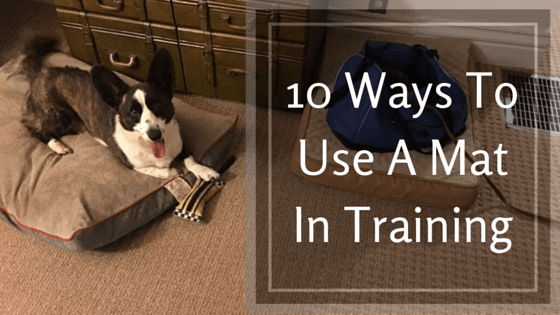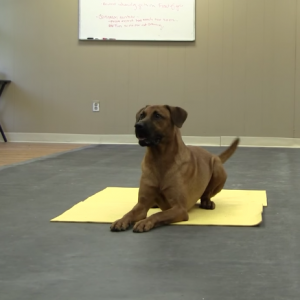10 Ways To Use A Mat In Training

Excellent Reasons to Use a Mat in Dog Training
A mat, or a defined place for a dog to “go to,” is a versatile and useful behavior to teach a dog. A mat can be many things: a dog bed, a dog mat, a bath mat, a towel, a blanket, a pillow — whatever makes the most sense for the dog and the handler.
1. As A “Place” For The Dog
Useful in emergencies, when clients can’t put their dog in a crate, when they have dropped something, or when they need to vacuum. This gets the dog out of danger quickly without a hassle.
2. Inviting Guests
A doorbell or knock can be the cue for a dog to go to his mat and wait while the client answers the door. This helps to prevent door dashing and impolite greetings.
3. Out From Underfoot In The Kitchen
Instead of being underfoot, the dog is waiting patiently on her mat for the client to finish preparing her meal and/or her medications.
4. Keep Visitors Happy
Some people are not terribly fond of dogs and some dogs are not terribly fond of visitors in their home. When a dog is comfortable on his mat, it makes social gatherings so much easier on everyone! The dog can be a part of the party, but at a safe distance for everyone.
5. Teaching Stay
Having a defined space helps some dogs better understand the concept of stay. The mat is a physical cue for them to lie down and be still.
6. Teaching Tricks
A very cute trick where the dog lies down on a blanket or mat, then grabs the corner of it and rolls herself up in the blanket or mat can be taught by starting with a go to the mat exercise.
7. Home Away From Home
While traveling, it is nice for a dog to have a familiar spot to lie down, to sleep, to hang out. A mat can be a great safety blanket for a dog.
8. Therapy Dog Work
There are many times in therapy dog work where dogs need to simply hang out. Using a mat defines this idea for the dogs and gives them a familiar space. Reading programs are a time/place where using a mat is very helpful and comforting to the dog, the handler, and the reader.
9. Working Outside
If the dog participates in outdoor activities in all kinds of weather, a mat will be helpful in giving the dog a clean, dry space to be. The mat also helps to protect the dog from hot or cold surface temperatures.
10. Defined Space
In a multiple dog house, or in a class situation, having a defined space a dog can call his own, without worrying about other dogs infringing on that space, can help the dog to feel more comfortable and more focused.
Get Dog Training Business Tips!
Receive valuable dog training business tips and resources every week! Subscribe to The Modern Dog Trainer now by submitting your name and email below.
[mc4wp_form]




